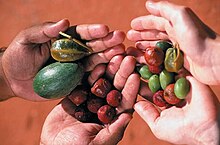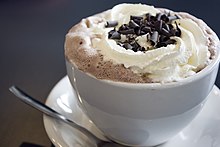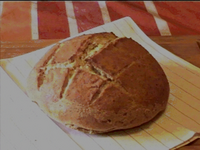F o o d
A portal dedicated to food and foodways
Introduction


Food is any substance consumed by an organism for nutritional support. Food is usually of plant, animal, or fungal origin and contains essential nutrients such as carbohydrates, fats, proteins, vitamins, or minerals. The substance is ingested by an organism and assimilated by the organism's cells to provide energy, maintain life, or stimulate growth. Different species of animals have different feeding behaviours that satisfy the needs of their metabolisms and have evolved to fill a specific ecological niche within specific geographical contexts.
Omnivorous humans are highly adaptable and have adapted to obtain food in many different ecosystems. Humans generally use cooking to prepare food for consumption. The majority of the food energy required is supplied by the industrial food industry, which produces food through intensive agriculture and distributes it through complex food processing and food distribution systems. This system of conventional agriculture relies heavily on fossil fuels, which means that the food and agricultural systems are one of the major contributors to climate change, accounting for as much as 37% of total greenhouse gas emissions. (Full article...)
Cooking, also known as cookery or professionally as the culinary arts, is the art, science and craft of using heat to make food more palatable, digestible, nutritious, or safe. Cooking techniques and ingredients vary widely, from grilling food over an open fire, to using electric stoves, to baking in various types of ovens, reflecting local conditions.
Preparing food with heat or fire is an activity unique to humans. Archeological evidence of cooking fires from at least 300,000 years ago exists, but some estimate that humans started cooking up to 2 million years ago.
The expansion of agriculture, commerce, trade, and transportation between civilizations in different regions offered cooks many new ingredients. New inventions and technologies, such as the invention of pottery for holding and boiling of water, expanded cooking techniques. Some modern cooks apply advanced scientific techniques to food preparation to further enhance the flavor of the dish served. (Full article...)
Food in England is a 1954 book by the social historian Dorothy Hartley. It is both a cookery book and a history of English cuisine. It was acclaimed on publication; the contemporary critic Harold Nicolson described the book as a classic. It has remained in print ever since.
The book provides what has been called an idiosyncratic and a combative take on the history of English cooking. The book is unusual as a history in not citing its sources, serving more as an oral social history from Hartley's own experiences as she travelled England as a journalist for the Daily Sketch, interviewing "the last generation to have had countryside lives sharing something in common with the Tudors." The book strikes some readers as principally a history, but it consists mainly of recipes. Some of these such as stargazey pie are old-fashioned, but all are practical recipes that can be cooked. (Full article...)
Selected article –
Bush tucker, also called bush food, is any food native to Australia and historically eaten by Indigenous Australians, the Aboriginal and Torres Strait Islander peoples, but it can also describe any native flora, fauna, or funga used for culinary or medicinal purposes, regardless of the continent or culture. Animal native foods include kangaroo, emu, witchetty grubs and crocodile, and plant foods include fruits such as quandong, kutjera, spices such as lemon myrtle and vegetables such as warrigal greens and various native yams.
Traditional Indigenous Australians' use of bushfoods has been severely affected by the settlement of Australia in 1788 and subsequent settlement by non-Indigenous peoples. The introduction of non-native foods, together with the loss of traditional lands, resulting in reduced access to native foods by Aboriginal people, and destruction of native habitat for agriculture, has accentuated the reduction in use. (Full article...)Selected cuisine -
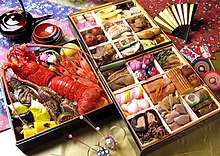
Japanese cuisine encompasses the regional and traditional foods of Japan, which have developed through centuries of political, economic, and social changes. The traditional cuisine of Japan (Japanese: washoku) is based on rice with miso soup and other dishes; there is an emphasis on seasonal ingredients. Side dishes often consist of fish, pickled vegetables, and vegetables cooked in broth. Seafood is common, often grilled, but also served raw as sashimi or in sushi. Seafood and vegetables are also deep-fried in a light batter, as tempura. Apart from rice, a staple includes noodles, such as soba and udon. Japan also has many simmered dishes, such as fish products in broth called oden, or beef in sukiyaki and nikujaga.
Historically influenced by Chinese cuisine, Japanese cuisine has also opened up to influence from Western cuisines in the modern era. Dishes inspired by foreign food—in particular Chinese food—like ramen and gyōza, as well as foods like spaghetti, curry and hamburgers, have been adapted to Japanese tastes and ingredients. Traditionally, the Japanese shunned meat as a result of adherence to Buddhism, but with the modernization of Japan in the 1880s, meat-based dishes such as tonkatsu and yakiniku have become common. Since this time, Japanese cuisine, particularly sushi and ramen, has become popular globally. (Full article...)Selected ingredient –
Whipped cream is heavy cream, double cream, or other high-fat cream that is whipped by a whisk or mixer until it is light and fluffy and holds its shape. Cream aerated by the expansion of dissolved gas, forming a firm colloid, is also called whipped cream. It is often sweetened, typically with white sugar, and sometimes flavored with vanilla. Whipped cream is also called Chantilly cream or crème Chantilly (French pronunciation: [kʁɛm ʃɑ̃tiji]). (Full article...)
Selected recipe –

Malagasy cuisine encompasses the many diverse culinary traditions of the Indian Ocean island of Madagascar. Foods eaten in Madagascar reflect the influence of Southeast Asian, African, Oceanian, Indian, Chinese and European migrants that have settled on the island since it was first populated by seafarers from Borneo between 100 CE and 500 CE. Rice, the cornerstone of the Malagasy diet, was cultivated alongside tubers and other Southeast Asian and Oceanian staples by these earliest settlers. Their diet was supplemented by foraging and hunting wild game, which contributed to the extinction of the island's bird and mammal megafauna. These food sources were later complemented by beef in the form of zebu introduced into Madagascar by East African migrants arriving around 1,000 CE.
Trade with Arab and Indian merchants and European transatlantic traders further enriched the island's culinary traditions by introducing a wealth of new fruits, vegetables, and seasonings. (Full article...)Selected image –
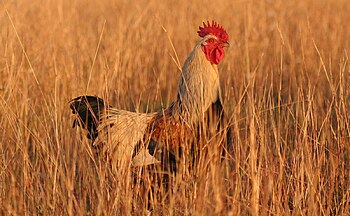
Selected biography –
Jane Grigson
B. March 13, 1928 – d. March 12, 1990
Jane Grigson (born Heather Mabel Jane McIntire; 13 March 1928 – 12 March 1990) was an English cookery writer. In the latter part of the 20th century she was the author of the food column for The Observer and wrote numerous books about European cuisines and traditional British dishes. Her work proved influential in promoting British food.
Born in Gloucestershire, Grigson was raised in Sunderland, North East England, before studying at Newnham College, Cambridge. In 1953 she became an editorial assistant at the publishing company Rainbird, McLean, where she was the research assistant for the poet and writer Geoffrey Grigson. They soon began a relationship which lasted until his death in 1985; they had one daughter, Sophie. Jane worked as a translator of Italian works, and co-wrote books with her husband before writing Charcuterie and French Pork Cookery in 1967. The book was well received and, on its strength, Grigson gained her position at The Observer after a recommendation by the food writer Elizabeth David. (Full article...)
Did you know (auto-generated) –

- ... that strawberry pie is one of the "red foods" traditionally served at Juneteenth celebrations?
- ... that an investigation found that most Mexican nutrition science students could not interpret a nutritional front-of-package labeling system correctly?
- ... that the fork-tailed drongo gives genuine alarm calls but will sometimes lie to steal food from other animals?
- ... that a British supermarket uses barriers to prevent shoppers grabbing food with yellow discount stickers out of the hands of staff?
- ... that during the 2021 food crisis in southern Madagascar, people have resorted to eating things such as raw red cactus fruits, wild leaves, locusts, ashes mixed with tamarind, and shoe leather?
- ... that certain Coccinellidae species lay extra infertile trophic eggs along with their fertile eggs so that their larvae can have a backup food source?
More did you know –
Related portals
Food topics
The following are topics relating to food
Categories
Food list articles
- See also: Lists of foods and Category:Lists of drinks
The following are some Food list articles on Wikipedia:

- American cheeses
- Appellation d'Origine Contrôlée cheeses
- Apple cultivars
- Bacon dishes
- Bacon substitutes
- Basil cultivars
- Breads
- Breakfast beverages
- Breakfast cereals
- Breakfast foods
- British cheeses
- Cakes
- Candies
- Cheeses
- Cheese soups
- Christmas dishes (list)
- Cocktails
- Cookies
- Dishes using coconut milk
- Diets
- Doughnut varieties
- Egg dishes
- Fermented soy products
- Food additives
- Food additives (Codex Alimentarius)
- Foods named after people
- French cheeses
- French dishes
- Fried dough foods
- Fruits
- List of hamburgers
- Herbs and spices
- Hors d'oeuvre
- Indian dishes
- Indian snack foods
- Indonesian dishes
- Italian dishes
- Japanese snacks
- Japanese dishes
- Jewish dishes
- Kebabs
- Korean beverages
- Mango cultivars
- Moroccan dishes
- Pasta
- Pastries
- Philippine snack food
- Pies, tarts and flans
- Poppy seed pastries and dishes
- Potato dishes
- Puddings
- Raw fish dishes
- Rice dishes
- Rolled foods
- Sauces
- Seafood
- Seeds
- Sandwiches
- Snack foods
- Soft drinks by country
- Soul foods and dishes
- Soups
- Stews
- Street foods
- Tapas
- Turkish dishes
- Twice-baked foods
- Vegetable oils
- Vegetables
- Vodkas
Things you can do
Related WikiProjects
| Parent project: WikiProject Food and Drink | |
| Child projects: | Task forces: (All inactive) |
|
|
| Related projects: | |
New articles
Rules | Match log | Results page (for watching) | Last updated: 2024-04-18 19:52 (UTC)
Note: The list display can now be customized by each user. See List display personalization for details.
- Taqua banana ( | talk | history | links | watch | logs | tools) by Fredo.fernando (talk · contribs · new pages (1)) started on 2024-04-18, score: 10
- Butifarra (sandwich) ( | talk | history | links | watch | logs | tools) by Tony24644 (talk · contribs · new pages (1)) started on 2024-04-18, score: 10
- Kuai Kuai ( | talk | history | links | watch | logs | tools) by Heeheemalu (talk · contribs · new pages (15)) started on 2024-04-17, score: 20
- Rocklands Barbeque and Grilling Company ( | talk | history | links | watch | logs | tools) by DarkNight0917 (talk · contribs · new pages (10)) started on 2024-04-17, score: 10
- Sweet Alchemy ( | talk | history | links | watch | logs | tools) by Another Believer (talk · contribs · new pages (97)) started on 2024-04-16, score: 10
- Diet Coke ( | talk | history | links | watch | logs | tools) by 99.196.135.213 (talk · contribs · new pages (1)) started on 2024-04-16, score: 20
- The Lakes Distillery ( | talk | history | links | watch | logs | tools) by ChefBear01 (talk · contribs · new pages (2)) started on 2024-04-16, score: 20
- Cully & Sully ( | talk | history | links | watch | logs | tools) by Liz (talk · contribs · new pages (74)) started on 2024-04-16, score: 30
- Trine Lotherington Danielsen ( | talk | history | links | watch | logs | tools) by Geschichte (talk · contribs · new pages (35)) started on 2024-04-16, score: 10
- Medical Device User Fee and Modernization Act ( | talk | history | links | watch | logs | tools) by GobsPint (talk · contribs · new pages (28)) started on 2024-04-16, score: 10
- Antioch Pizza ( | talk | history | links | watch | logs | tools) by Ms.Aloisia (talk · contribs · new pages (1)) started on 2024-04-15, score: 10
- Guelaguetza (restaurant) ( | talk | history | links | watch | logs | tools) by Another Believer (talk · contribs · new pages (97)) started on 2024-04-15, score: 10
- The Burque Bakehouse ( | talk | history | links | watch | logs | tools) by Another Believer (talk · contribs · new pages (97)) started on 2024-04-12, score: 10
- Uneeda Biscuit ( | talk | history | links | watch | logs | tools) by CNMall41 (talk · contribs · new pages (42)) started on 2024-04-10, score: 30
- Bersagh ( | talk | history | links | watch | logs | tools) by Hosseinblue (talk · contribs · new pages (1)) started on 2024-04-15, score: 10
- Lucky Saint ( | talk | history | links | watch | logs | tools) by DanielMichaelPerry (talk · contribs · new pages (2)) started on 2024-04-14, score: 20
- The Yeti Cafe ( | talk | history | links | watch | logs | tools) by PerfectSoundWhatever (talk · contribs · new pages (2)) started on 2024-04-14, score: 10
- Fábrica Santo António ( | talk | history | links | watch | logs | tools) by AtlanteanAstorian (talk · contribs · new pages (1)) started on 2024-04-13, score: 10
- Cocoa-free chocolate alternative ( | talk | history | links | watch | logs | tools) by Jesskarch (talk · contribs · new pages (2)) started on 2024-04-12, score: 10
- Banana cream pie ( | talk | history | links | watch | logs | tools) by Valereee (talk · contribs · new pages (6)) started on 2024-04-13, score: 30
- Menus-Plaisirs – Les Troisgros ( | talk | history | links | watch | logs | tools) by Cavarrone (talk · contribs · new pages (68)) started on 2024-04-13, score: 20
- 2024 Andy's Frozen Custard 300 ( | talk | history | links | watch | logs | tools) by MysticCipher87 (talk · contribs · new pages (1)) started on 2024-04-08, score: 10
- Gusto Bread ( | talk | history | links | watch | logs | tools) by Another Believer (talk · contribs · new pages (97)) started on 2024-04-12, score: 10
- Korenya Shingetsuan ( | talk | history | links | watch | logs | tools) by Loukus999 (talk · contribs · new pages (7)) started on 2024-04-12, score: 10
- 321 Coffee ( | talk | history | links | watch | logs | tools) by Sirdog (talk · contribs · new pages (1)) started on 2024-04-12, score: 10
- Wei Lih Men ( | talk | history | links | watch | logs | tools) by Heeheemalu (talk · contribs · new pages (15)) started on 2024-04-12, score: 20
- Pescado a la talla ( | talk | history | links | watch | logs | tools) by Opus88888 (talk · contribs · new pages (1)) started on 2024-04-11, score: 20
- David S. Shellabarger ( | talk | history | links | watch | logs | tools) by Vanderwaalforces (talk · contribs · new pages (117)) started on 2024-04-11, score: 10
- Pan minisc' ( | talk | history | links | watch | logs | tools) by Mariamnei (talk · contribs · new pages (18)) started on 2024-04-11, score: 20
- Imperial Big Meal ( | talk | history | links | watch | logs | tools) by Heeheemalu (talk · contribs · new pages (15)) started on 2024-04-11, score: 20
- Prince Noodles ( | talk | history | links | watch | logs | tools) by Heeheemalu (talk · contribs · new pages (15)) started on 2024-04-11, score: 20
- TTL Hua Tiao Chicken Noodles ( | talk | history | links | watch | logs | tools) by Heeheemalu (talk · contribs · new pages (15)) started on 2024-04-11, score: 20
- List of Michelin starred restaurants in Vietnam ( | talk | history | links | watch | logs | tools) by Crcolas (talk · contribs · new pages (13)) started on 2024-04-10, score: 20
- Food journalism ( | talk | history | links | watch | logs | tools) by Sadads (talk · contribs · new pages (14)) started on 2024-04-10, score: 10
- The Hangover (Suzanne Valadon) ( | talk | history | links | watch | logs | tools) by Viriditas (talk · contribs · new pages (5)) started on 2024-04-10, score: 20
- Caidao ( | talk | history | links | watch | logs | tools) by Belarus101 (talk · contribs · new pages (3)) started on 2024-04-10, score: 10
- Wobble to Death ( | talk | history | links | watch | logs | tools) by Lord Cornwallis (talk · contribs · new pages (132)) started on 2024-04-09, score: 10
- Maple bacon donut ( | talk | history | links | watch | logs | tools) by Nikkimaria (talk · contribs · new pages (2)) started on 2024-04-09, score: 40
- Julia's ( | talk | history | links | watch | logs | tools) by Another Believer (talk · contribs · new pages (97)) started on 2024-04-07, score: 10
- The Red Door (restaurant) ( | talk | history | links | watch | logs | tools) by Another Believer (talk · contribs · new pages (97)) started on 2024-04-05, score: 10
- King (restaurant) ( | talk | history | links | watch | logs | tools) by MainlyTwelve (talk · contribs · new pages (5)) started on 2024-04-08, score: 10
- Shanzhagao ( | talk | history | links | watch | logs | tools) by Jeromeenriquez (talk · contribs · new pages (11)) started on 2024-04-08, score: 10
- Flambé (comics) ( | talk | history | links | watch | logs | tools) by 213.233.154.158 (talk · contribs · new pages (1)) started on 2024-04-07, score: 10
- Mad honey ( | talk | history | links | watch | logs | tools) by Gobonobo (talk · contribs · new pages (22)) started on 2024-04-07, score: 20
- Arook ( | talk | history | links | watch | logs | tools) by TheRabbi613 (talk · contribs · new pages (4)) started on 2024-04-07, score: 20
- Kaji Nemu ( | talk | history | links | watch | logs | tools) by AjayDas (talk · contribs · new pages (3)) started on 2024-04-07, score: 10
- Pakistan Halal Authority ( | talk | history | links | watch | logs | tools) by Ainty Painty (talk · contribs · new pages (17)) started on 2024-04-07, score: 10
- Tea in France ( | talk | history | links | watch | logs | tools) by Beatrizsborges (talk · contribs · new pages (10)) started on 2024-04-06, score: 20
- The Woods (Seattle) ( | talk | history | links | watch | logs | tools) by Another Believer (talk · contribs · new pages (97)) started on 2024-04-06, score: 10
- Marinated mushrooms ( | talk | history | links | watch | logs | tools) by Oliwiasocz (talk · contribs · new pages (29)) started on 2024-04-06, score: 30
- Kisi Ka Bhai Kisi Ki Jaan (soundtrack) ( | talk | history | links | watch | logs | tools) by 103.166.245.177 (talk · contribs · new pages (2)) started on 2024-04-06, score: 10
- Cheese zombie ( | talk | history | links | watch | logs | tools) by Falcorian (talk · contribs · new pages (1)) started on 2024-04-05, score: 10
- Wood Shop BBQ ( | talk | history | links | watch | logs | tools) by Another Believer (talk · contribs · new pages (97)) started on 2024-04-05, score: 10
- Mountain soap ( | talk | history | links | watch | logs | tools) by Namesnik (talk · contribs · new pages (11)) started on 2024-04-05, score: 10
- B.F. Clyde's Cider Mill ( | talk | history | links | watch | logs | tools) by Naufragiosus (talk · contribs · new pages (5)) started on 2024-04-04, score: 10
- The Fifth Avenue Hotel ( | talk | history | links | watch | logs | tools) by Meghws (talk · contribs · new pages (1)) started on 2024-04-04, score: 10
- KWV South Africa ( | talk | history | links | watch | logs | tools) by MicrobiologyMarcus (talk · contribs · new pages (80)) started on 2024-04-04, score: 20
- Priyagold ( | talk | history | links | watch | logs | tools) by Kaal321 (talk · contribs · new pages (3)) started on 2024-04-03, score: 20
- New World Whisky ( | talk | history | links | watch | logs | tools) by ChefBear01 (talk · contribs · new pages (2)) started on 2024-03-29, score: 10
Associated Wikimedia
The following Wikimedia Foundation sister projects provide more on this subject:
-
 Commons
Commons
Free media repository -
 Wikibooks
Wikibooks
Free textbooks and manuals -
 Wikidata
Wikidata
Free knowledge base -
 Wikinews
Wikinews
Free-content news -
 Wikiquote
Wikiquote
Collection of quotations -
 Wikisource
Wikisource
Free-content library -
 Wikiversity
Wikiversity
Free learning tools -
 Wiktionary
Wiktionary
Dictionary and thesaurus























